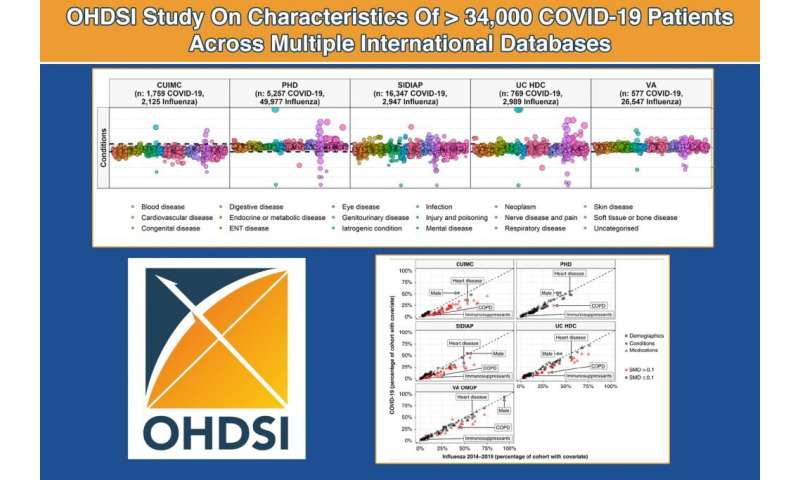
Patients hospitalized with COVID-19 were more likely male, younger, and, in both the US and Spain, had fewer comorbidities and lower medication use than hospitalized influenza patients according to a recent study published by the Observational Health Data Sciences and Informatics (OHDSI) community.
OHDSI has established an international network of researchers and observational health databases with a central coordinating center housed at the Department of Biomedical Informatics at Columbia University.
This global network study, which included more than 34,000 COVID-19 patients from across three continents, is intended to provide greater detail about the characteristics of patients suffering from the disease, and also to help inform decision-making around the care of hospitalized patients.
The study “Deep phenotyping of 34,128 adult patients hospitalized with COVID-19 in an international network study” was published Oct. 6 by Nature Communications.
Patients hospitalized with COVID-19 were more typically male in the US and Spain, but more often female in South Korea. The ages of patients varied, but in Spain and the US, the most common age groups were between 60 to 75. Patients hospitalized with influenza were typically older than those hospitalized with COVID-19, and more likely to be female.
Many of the patients hospitalized with COVID-19 were seen to have other health conditions. For example, the prevalence of hypertensive disorder ranged from 24% to 70%, diabetes from 13% to 43%, and asthma from 4% to 15%, across data sources. Despite this, however, when compared to patients hospitalized with influenza in recent years, those with COVID-19 were seen to generally be healthier. Chronic obstructive pulmonary disease (COPD), cardiovascular disease and dementia were all more common among those hospitalized with influenza compared to those hospitalized with COVID-19.
“This study has allowed us to better understand the profiles of patients hospitalized with COVID-19,” says co-lead author Edward Burn. “Despite recent discourse around the supposed poor health and limited life expectancy of COVID-19 patients, we see COVID-19 patients to be in no worse health than those typically hospitalized with influenza. This further highlights the high rate of mortality among COVID-19 patients.”
This study was initiated during the OHDSI COVID-19 study-a-thon, an 88-hour global, inter-disciplinary collaboration. The initial COVID-19 data was provided by the Korean Health Insurance Review & Assessment Service (HIRA), and it empowered the community to generate some of the earliest multi-national studies during the pandemic. All analyses are performed at the individual sites, meaning no patient-level data needed to be shared and patient privacy could be maintained.
“The most interesting part of this study is that it was possible to provide the details of patients’ characteristics across institutions without violating their privacy,” said co-lead author Seng Chan You, who helped lead the efforts of mapping HIRA data to the OHDSI common data model. “It’s important to know this is possible because we don’t know what is coming next. When is the next pandemic? Whatever happens, we know we can provide important patient characteristics to allow collaborative global research.”
The study was developed and executed by the OHDSI community, a multi-stakeholder, interdisciplinary collaboration that works to bring out the value of health data through large-scale analytics. All solutions are open-source, and links to the study protocol, code and results are posted in the paper.
“Open science and collaboration are tenets of the OHDSI community, and they were never more important than early in this pandemic,” said Patrick Ryan, co-senior author of this study. “Our community collaborated for years to develop the high-level analytics which set the course for these studies, and our belief in both openly sharing patient data allowed us to generate this reliable, reproducible COVID patient data that will assist in important decision-making as we fight this disease.”
Source: Read Full Article
